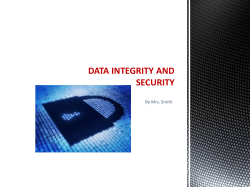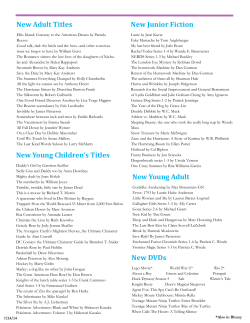
effect of haemogregarina stepanovi danilewsky, 1885
Revista Scientia Parasitologica 2004, 5(1-2):71-74 EFFECT OF HAEMOGREGARINA STEPANOVI DANILEWSKY, 1885 (APICOMPLEXA:HAEMOGREGARINIDAE) ON ERYTHROCYTE MORPHOLOGY IN THE EUROPEAN POND TURTLE, EMYS ORBICULARIS (LINNAEUS, 1758) BLANFORD, 1876 (TESTUDINES:EMYDIDAE) Mihalca A.D., Cozma V., Gherman C., Achelăriţei D. University of Agricultural Sciences and Veterinary Medicine, Faculty of Vererinary Medicine, Department of Parasitology and Parasitic Diseases, str. Mănăştur 3, 400372, Cluj-Napoca, Romania, email: amihalca@usamvcluj.ro Key words: Haemogregarina, Emys, erythrocyte morphology Abstract. Changes in erythrocyte morphology were studied in five european pond turtles (Emys orbicularis) infected with microgametoytes and trophozoites of Haemogregarina stepanovi. Shape alterations were mor pronounced in erythrocytes infected with trophozoites. The more severely affected morphometrical parameters were shape index of erythrocytes and shape index of the nucleus. INTRODUCTION Haemogregarina stepanovi has been described by Danilewsky in 1885 and has been reported by many authors in the European pond turtle, Emys orbicularis. Hahn (1909) described in detail the stages in the turtle. Reichenow (1910) published a detailed review on the species. Mihalca (2002) described the effect of the infection on the differential blood count of Emys orbicularis. The intraerythrocytic stages in turtles include trophozoites, macroschizonts, macromerozoites, microschizonts, micromerozoites, microgametocytes and macrogametocytes. Part of these stages and transformations take place in the bone marrow, only a few stages being seen in the peripheric blood. In this paper we present the results of the study of the effect of infection with Haemogregarina stepanovi trophozoites and microgametcoytes on erythrocytic morphology in turtles. MATERIAL AND METHOD Five turtles, infected with Haemogregarina stepanovi, collected from Drăgăşani (Vâlcea County, Romania) were used in this study. Blood was collected from the coccigian vein using heparin as anticoagulant. Smears were stained using Dia Panoptic ® (Reagens Kft; Diagon Kft, Hungary) method and examined with the immersion objective of an Olympus BX41® microscope. Pictures were taken with an Olympus DP10 ® digital camera and measured using Adobe Photoshop 6.0. From each turtle, 60 erythrocytes were measured (20 uninfected, 20 infected with trophozoites and 20 infected with microgametocytes). Four parameters were taken in account: length of erythrocyte (L), width of erythrocyte (W), length of nucleus (Ln) and width of nucleus (Wn). Four indexes were calculated: L/W, Ln/Wn, L/Ln and W/Wn. Some staining properties and cytomorphology aspects are also commented. RESULTS AND DISCUSSIONS In erythrocytes infected with trophozoites, the nucleus was displaced either in marginal position (figure 1) or in polar position (figure 2) with normal or elongated shape. In both cases, the nucleus was stained more intensly than in normal erythrocytes. In some cases, a vacuole can be noticed around the trophozoite (figure 3). In other cases, the erythrocytes can take abnormal shapes with expansions (figure 4). Sometimes the erythrocytes can be ruptured and trophozoites seen free, outside the cell (figure 5). In erythrocytes infected with microgametocytes, usually the nucleus preserves its position. Some nuclei preserve their shape (figure 6) while others have irregular shapes (figure 7). Severe cell shape alteration can occure in erythrocites infected with microgametocytes (figure 8). Double infections with microgametocytes rarely occure (figure 9). The morphometric values of normal and infected erythrocytes is shown in table 1. The ratios between morphometric parameters are shown in table 2. Figures: 1. Marginal displacement of the nucleus. 2. Apical displacement of the nucleus. 3. Vacuole around the trophozoite. 4. Abnormal shape of eythrocyte. 5. Free trophozoite. 6. Nucleus with normal shape apical displacement. 7. Irregular shape of nucleus. 8. Altered shape of erythrocytes. 9. Double infection with microgametocytes Table 1 Morphometric values of normal erythrocytes (N) compared to erythrocytes infected with microgametcoytes (M) and trophozoites (T) of Haemogregarina stepanovi L N M T 19,99 19,92 20,68 ± ± ± Emo1 1,23 0,85 1,56 20,36 19,51 22.62 ± ± ± Emo2 1,26 0,81 0,95 21,89 19,15 22,13 ± ± ± Emo3 1,35 0,49 1,43 20,01 19,92 22,93 ± ± ± Emo4 1.30 1,63 1,76 19,93 19,63 22,13 ± ± ± Emo6 1,13 1,13 1,51 Mean 20.44 19.63 22.10 St dev 0.83 0.32 0.86 * - values outside normal ranges Turtle N 12,39 ± 0,74 12,45 ± 0,96 13,67 ± 0,77 12.77 ± 0,78 12,78 ± 0,95 12.92 0.45 W M 11,87 ± 1,10 12,01 ± 1,20 12,05 ± 1,77 11,43 ± 1,23 11,95 ± 0,74 11.86 0.25 T 11,39 ± 1,23 11,84 ± 0,70 13,21 ± 1,22 11.07 ± 2,28 13,13 ± 1,60 12.13 0.99 N 6,65 ± 0,50 7,20 ± 0,71 6,71 ± 0,71 6,25 ± 0,65 7,11 ± 0,66 6.78 0.38 Ln M 6,19 ± 0,59 6,62 ± 0,91 6,33 ± 1,23 6,25 ± 0,56 6,75 ± 0,72 6.43 0.24 T 7,97 ± 0,78 7,93 ± 0,78 8,32 ± 0,98 8,00 ± 0,48 8,20 ± 0,28 8.08 0.17 N 4,20 ± 0,35 4,90 ± 0,47 4,55 ± 0,43 4,73 ± 0,46 4,85 ± 0,40 4.65* 0.28 Wn M 3,55 ± 1,10 3,78 ± 0,89 3,73 ± 0,75 3,82 ± 0,54 4,42 ± 0,60 3.86* 0.33 T 2,86 ± 0,28 3,13 ± 0,50 3,10 ± 0,93 3,24 ± 0,34 3,40 ± 0,28 3.15* 0.20 Table 2 Morphometric ratios of normal erythrocytes (N) compared to erythrocytes infected with microgametcoytes (M) and trophozoites (T) of Haemogregarina stepanovi L/W N M T 1,62 1,69 1,84 ± ± ± Emo1 0,14 0,11 0,28 1,64 1,62 1,92 ± ± ± Emo2 0,11 0,12 0,17 1,61 1,60 1,69 ± ± ± Emo3 0,12 0,19 0,20 1,57 1,76 2,16 ± ± ± Emo4 0,13 0,26 0,61 1,57 1,65 1,69 ± ± ± Emo6 0,13 0,12 0,09 Mean 1.60 1.66 1.86 St dev 0.03 0.06 0.19 * - values outside normal ranges Turtle N 1,59 ± 0,16 1,48 ± 0,19 1,49 ± 0,25 1,34 ± 0,20 1,47 ± 0,16 1.47 0.09 Ln/Wn M 1,94 ± 0,82 1,75 ± 0,44 1,77 ± 0,69 1,68 ±0,35 1,55 ± 0,27 1.74 0.14 T 2,81 ± 0,32 2,61 ± 0,56 2,94 ± 1,02 2,47 ± 0,12 2,42 ± 0,12 2.65* 0.22 N 3,02 ± 0,29 2,85 ± 0,30 3,29 ± 0,31 3,24 ± 0,44 2,82 ± 0,18 3.04 0.22 L/Ln M 3,24 ± 0,31 2,95 ± 0.32 3,07 ± 0,52 3,21 ± 0,38 2,93 ± 0,31 3.08 0.14 T 2,62 ± 0,32 2,88 ± 0,39 2,70 ± 0,36 2,88 ± 0,34 2,70 ± 0,09 2.76 0.12 N 2,96 ± 0,24 2,56 ± 0,25 3,03 ± 0,30 2,72 ± 0,24 2,64 ± 0,20 2.78 0.20 W/Wn M 3,66 ± 1,34 3,17 ± 0,87 3,34 ± 1,15 3,07 ± 0,63 2,75 ± 0,41 3.20 0.34 T 4,02 ± 0,57 3,87 ± 0,61 4,67 ± 1,63 3,41 ± 0,63 3,86 ± 0,15 3.97 0.46 As shown in the tables above, the infection with Haemogregarina stepanovi induces different erythocytic changes, depending on the infective stage. The more marked changes occur in the case of infection with trophozoites, because of their large size. The erythrocytes are longer and slightly thinner with a higher L/W ratio. The length of the nucleus is also increased but its width is reduced giving a flattened aspect to the nucleus. In erythrocytes infected with microgametocytes, the changes are less evident. The cells are slightly smaller, with a smaller and flattened nucleus. Normal morphometric values of erythrocytes in Emys orbicularis was studied by Uğurtaş et al. (2003) in Turkey. They found the following ranges: L = 19.52-23.18; W = 10.98-14.64; L/W = 1.50-2.05; Ln = 6.10-8.54; Wn = 4.88-6.71; Ln/Wn = 0.90-1.75. According to these data, in our turtles, all morphometric values for uninfected erythrocytes are within these ranges except the width of the nucleus which is slightly narrower than in turtles from Turkey. In the infected erythrocytes, there are values which do not fit in the normal ranges presented by the turkish authors. Thus, the nucleus of the infected erythrocytes (with microgametocytes or with trophozoites) is more narrow and nucleus shape index is also higher in erythrocytes infected with trophozoites. We also have to consider the possibility that in infected turtles, the uninfeced erythrocytes could suffer morphological changes but further studies need to be done. BIBLIOGRAPHY 1. 2. 3. 4. Hahn C.W., 1909, The stages of Haemogregarina stepanovi Danilewsky found in the blood of turtles with especial reference to changes in the nucleus, Archiv für Protistenkunde 17:307-376 Mihalca A.D., Achelăriţei D., Popescu P., 2002, Haemoparasites of the genus Haemogregarina in a population of european pond turtles (Emys orbicularis) from Drăgăşani, Vâlcea county, Romania, Revista Scientia Parasitologica 3(2):22-27 Reichenow E., 1910, Haemogregarina stepanowi. Die Entwicklungsgeschichte einer Hämogregarine, Archiv für Protistenkunde 20:251-350 Uğurtaş I.H., Sevinç M., Yildirimhan H.S., 2003, Erythrocyte size and morphology os some tortoises and turtles from Turkey, Zoological Studies 42(1):173-178
© Copyright 2025










